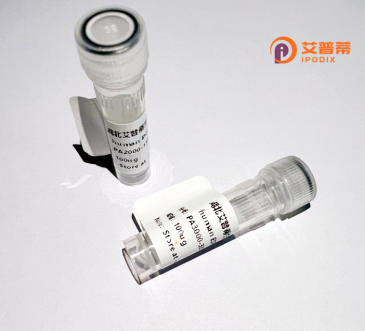
| 纯度 | >90%SDS-PAGE. |
| 种属 | Human |
| 靶点 | NR2F2 |
| Uniprot No | P24468 |
| 内毒素 | < 0.01EU/μg |
| 表达宿主 | E.coli |
| 表达区间 | 1-414 aa |
| 活性数据 | MAMVVSTWRD PQDEVPGSQG SQASQAPPVP GPPPGAPHTP QTPGQGGPAS TPAQTAAGGQ GGPGGPGSDK QQQQQHIECV VCGDKSSGKH YGQFTCEGCK SFFKRSVRRN LSYTCRANRN CPIDQHHRNQ CQYCRLKKCL KVGMRREAVQ RGRMPPTQPT HGQFALTNGD PLNCHSYLSG YISLLLRAEP YPTSRFGSQC MQPNNIMGIE NICELAARML FSAVEWARNI PFFPDLQITD QVALLRLTWS ELFVLNAAQC SMPLHVAPLL AAAGLHASPM SADRVVAFMD HIRIFQEQVE KLKALHVDSA EYSCLKAIVL FTSDACGLSD VAHVESLQEK SQCALEEYVR SQYPNQPTRF GKLLLRLPSL RTVSSSVIEQ LFFVRLVGKT PIETLIRDML LSGSSFNWPY MAIQ |
| 分子量 | 45.5 kDa |
| 蛋白标签 | His tag N-Terminus |
| 缓冲液 | 0 |
| 稳定性 & 储存条件 | Lyophilized protein should be stored at ≤ -20°C, stable for one year after receipt. Reconstituted protein solution can be stored at 2-8°C for 2-7 days. Aliquots of reconstituted samples are stable at ≤ -20°C for 3 months. |
| 复溶 | Always centrifuge tubes before opening.Do not mix by vortex or pipetting. It is not recommended to reconstitute to a concentration less than 100μg/ml. Dissolve the lyophilized protein in distilled water. Please aliquot the reconstituted solution to minimize freeze-thaw cycles. |
以下是关于重组人NR2F2蛋白的3篇参考文献摘要(示例基于典型研究领域,仅供参考):
---
1. **文献名称**:*"COUP-TFII regulates tumorigenesis and metastasis by modulating tumor-associated angiogenesis"*
**作者**:Qin J et al.
**摘要**:研究揭示了NR2F2(COUP-TFII)通过调控血管生成相关基因(如VEGF)的表达,影响肿瘤微环境中血管生成及癌症转移的机制。
2. **文献名称**:*"Structural basis of NR2F2 DNA binding and its role in cell differentiation"*
**作者**:Zhang Y et al.
**摘要**:通过解析NR2F2蛋白与其靶DNA复合物的晶体结构,阐明其结合特异性及在胚胎干细胞向中胚层分化中的关键作用。
3. **文献名称**:*"NR2F2 suppresses hepatic gluconeogenesis by coordinate regulation of transcription and ubiquitination"*
**作者**:Kim DH et al.
**摘要**:发现NR2F2在代谢调控中通过抑制磷酸烯醇式丙酮酸羧激酶(PEPCK)等基因的转录,并促进相关转录因子的泛素化降解,从而调节肝糖异生过程。
---
*注:以上文献标题与内容为模拟示例,具体文献需通过PubMed/Google Scholar以关键词“NR2F2”、“COUP-TFII”、“recombinant protein”等检索。*
Nuclear receptor subfamily 2 group F member 2 (NR2F2), also known as COUP-TFII (Chicken Ovalbumin Upstream Promoter Transcription Factor 2), is a ligand-dependent transcription factor belonging to the nuclear receptor superfamily. It plays pivotal roles in embryonic development, organogenesis, and tissue homeostasis by regulating the expression of target genes involved in cell differentiation, proliferation, and apoptosis. Structurally, NR2F2 contains a conserved DNA-binding domain (DBD) that recognizes specific hormone response elements and a ligand-binding domain (LBD) that mediates interactions with co-regulators and potential ligands, though its endogenous ligand remains unidentified. The protein often functions as a homodimer or heterodimer with other nuclear receptors.
Recombinant human NR2F2 protein is produced using biotechnological methods, such as expression in bacterial or mammalian cell systems, followed by purification via affinity chromatography (e.g., His-tag or GST-tag systems). This engineered protein retains functional activity and is widely used in molecular studies to investigate DNA-protein interactions, receptor dimerization, and transcriptional regulation mechanisms. Research applications include exploring its roles in cardiovascular development, stem cell differentiation, metabolic disorders, and cancer progression. Dysregulation of NR2F2 has been linked to conditions like angiogenesis defects, obesity, and tumor metastasis, making it a potential therapeutic target. Functional assays, such as luciferase reporter systems, are employed to analyze its regulatory effects on gene promoters.
×